
Welcome to Using Graphic Novels in Education, an ongoing feature from CBLDF designed to highlight the depth and complexity of graphic novels and to help parents and teachers raise readers. In this column, we provide teaching and discussion suggestions for the use of such books in education.
Discussion and Activity Guide: The Prince and the Dressmaker by Jen Wang
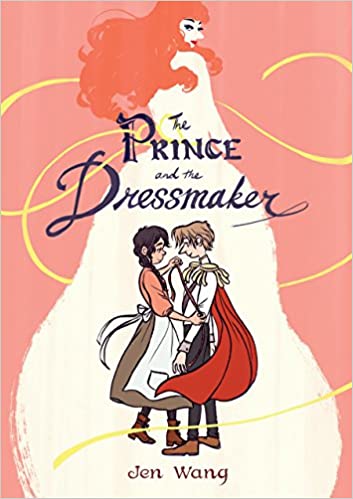
Inspired by fairy tales but not limited by conventions, The Prince and the Dressmaker, written and illustrated by Jen Wang, is the tale of Prince Sebastian, his best friend Frances, and the secrets and dreams they share with one another. Prince Sebastian is expected by society and family to find his bride by meeting eligible young women. However, his dream is to be able to live and be accepted as his whole self, including his secret identity as the daring and fashionable Lady Crystallia who is quickly becoming the hottest fashion icon in Paris! For Frances, Sebastian’s brilliant dressmaker and best friend, keeping his secret is also keeping her from her dream: to become the next great fashion designer. Can these two be true to themselves and also support each other’s dreams? With hope, humor, and a lot of love, The Prince and the Dressmaker reimagines what “happily ever after” can look like.
Themes: acceptance and inclusion, identity, friendship, family, speaking up, coming of age
GRAPHIC NOVEL DISCUSSION AND ACTIVITY GUIDE CONTENTS
- ABOUT THE AUTHOR/ARTIST/BOOK
- PRE-READING/ANTICIPATORY ACTIVITY
- CRITICAL THINKING QUESTIONS BY COMPLEXITY
- ACTIVITIES/PROJECTS
- PROSE, POETRY, AND GRAPHIC NOVEL PAIRINGS
- ADDITIONAL RESOURCES
- COMMON CORE STANDARDS
ABOUT THE AUTHOR/ARTIST/BOOK
Jen Wang is the award-winning, New York Times Bestselling author and illustrator of several graphic novels for young readers including Stargazing, The Prince and The Dressmaker, In Real Life (co-written with Cory Doctorow), and Koko Be Good. She is also a co-founder and organizer for Comic Arts LA. She lives in Los Angeles.
When she was growing up, Wang was hugely inspired as an artist and storyteller by Disney movies. In an interview with Book Riot she said, “The first time I can really remember thinking about narrative storytelling was when I watched The Little Mermaid when I was a kid. I remember thinking that it was somebody’s job to do, to draw everything. There was just something really magical about it that I wanted to be able to do.”
Wang uses a mechanical pencil and standard Bristol drawing paper when she draws. She inks by hand using a brush and then digitally adds color by scanning her line art into Photoshop. She says this blended technique, part hand drawn and part digital, is how she started drawing comics in high school and has stuck with it ever since!
Jen Wang’s website: https://www.jenwang.net/
Book Riot Interview: https://bookriot.com/2018/02/06/prince-and-the-dressmaker/
Awards: Eisner Award: Best Publication For Teens (2018), Angoulême Award: Best Youth Album Of The Year (2018), Harvey Award For Best Children’s Or Young Adult Book (2018)
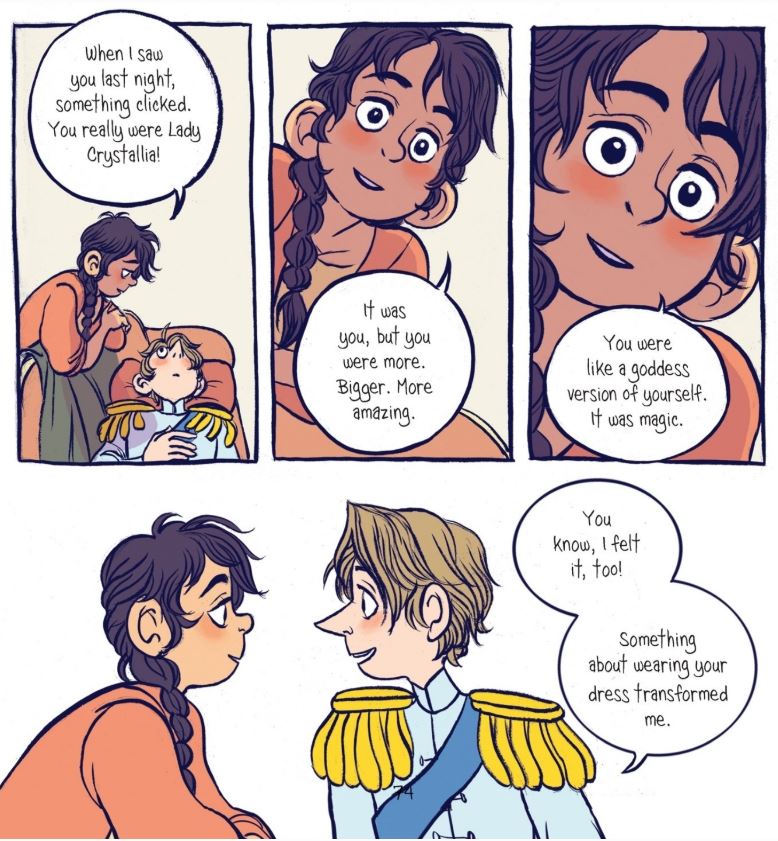
PRE-READING/ANTICIPATORY ACTIVITY
Introducing Inference: Inference is the ability to make predictions about something new based on what you already know or have experienced. The Prince and the Dressmaker relies on several page spreads where the characters’ thoughts and emotions must be inferred from the artwork. Have students create a three column chart labelled “Image” “Inference” and “Knowledge.” Show them this short shadow dance performance by Hungarian troupe Attraction on “Britain’s Got Talent” (https://youtu.be/Gine8SojWoY). The dance tells a complete story without words. Re-watch the dance, pausing after the opening scene to model how to note a quick description of the image, the key inferences one might make, and the prior knowledge/experience that informs that inference. Emphasize that every person may infer something unique to them depending on what experience and knowledge they have. For example, someone who has had a child would have different experiences to make inferences from than someone who has not. Continue for the whole performance, pausing as necessary, to allow students time to fill in their chart independently. Then, choose a few scenes to discuss the emotions, thoughts, and actions that a viewer might infer in order to understand the story.
An inference chart can be used as students are reading The Prince and the Dressmaker; there is also an extended inference activity listed in this guide.

CRITICAL THINKING QUESTIONS BY COMPLEXITY
Remembering
- What events lead to Frances being offered a job as Prince Sebastian’s seamstress?
- Why does Peter Trippley think Frances should work for his family’s department store?
Understanding
- Both Frances and Sebastian feel society expects certain behaviors from them. Make a list of expectations they each face.
- Using quotes and descriptions of imagery in the book, explain the importance of Emile to the outcome of the story.
Applying
- In Chapter Ten, after Sebastian has run away, Frances tells the King, “The thing that ruined Sebastian was how afraid he was of what you’d think of him.” Make a list of five things young people are afraid others will think of them along with a suggestion for overcoming the fear.
- The proverb “the clothes make the man,” which means others may judge you based on what you wear, has been around for thousands of years. Make a list of situations where what you wear is important because of how others will treat you.
Analyzing
- Several characters in this story chose to defy conventions and go against what was expected of them. Choose one character and describe what they do. Why do you think they made this choice?
- Towards the end of the book, in Chapter 11, the King tells Frances, “When I first learned the truth, I thought Sebastian’s life would be ruined. But seeing you, I realized everything would be fine. Because someone still loved him.” Describe Frances’ words or actions throughout the story that show her love for Sebastian.
Evaluating
- In Chapter Eight, Frances has the opportunity to introduce herself to her idol, Madame Aurelia. Do you think Frances made the right choice when she says she is “no one”? Why or why not?
- Although the story is set in the past, the author chose to have characters use modern language. Use examples from the text to explain whether this contrast between historical setting and modern language works or not.
Creating
- In Chapter One, Frances designs a dress for a customer who wants her to make a “ghastly” dress. In Chapter Two, Sebastian asks for a dress that is “fruit-jam” inspired. Look through books or search the internet to learn an interesting new word. Design an outfit that reflects the meaning of the word and share it, along with the word and its definition.
- Like many fairytales, the prince’s family expects that he’ll meet and marry the daughter of other aristocrats or royals. This fairytale ends differently. Write a proclamation for the people of Sebastian’s country that explains what changes will be made.

ACTIVITIES/PROJECTS
Inference and Imagery: This can be used as an extension of the pre-reading activity. Inference is the ability to make predictions about new information based on information you already know. The Prince and the Dressmaker relies on several page spreads where the characters’ thoughts and emotions must be inferred from the artwork. Have students create a three column chart labelled “Image” “Inference” and “Knowledge.” Choose a scene to show the class and work together through each image, modeling how to note a quick description of the image, the key inferences one might make, and the prior knowledge/experience that informs that inference. A good scene is in Chapter One when Frances’ first customer shocks guests at the Prince’s ball with her outfit and behavior. Discuss the emotions, thoughts, and actions happening in this scene that a reader needs to infer in order to understand the story. Then, assign groups of students different scenes from the book to break down in the same way. Lastly, ask students to write out the scene as a prose narrative, using descriptions and internal or external dialog to put into words what they inferred from the images.

2. Fashion Statement: In an interview with Forbes, author Jen Wang said, “I’d been wanting for a while to do a story about a character whose superpower is making clothes that transform the wearer.” Fashion plays a central role in The Prince and the Dressmaker. Ask students to draw a three columned chart, labelling the columns: Fashion, Helpful, Harmful. Watch Kaustav Dey talk about how fashion is a form of expression. Rewatch, giving students time to fill in explanations of how fashion from the talk was helpful to the wearer as well as times it was hurtful. Discuss how reactions to fashion change depending on context (who, when, where, why, or how the fashion was worn). Then, have them add items from the book, and finally, examples from their lives. For example, when a uniform, a band t-shirt, or a bathing suit may be helpful or harmful to wear in different contexts.
TED Talk: https://www.ted.com/talks/kaustav_dey_how_fashion_helps_us_express_who_we_are_and_what_we_stand_for
Forbes Interview: https://www.forbes.com/sites/laurenorsini/2018/02/12/the-prince-and-the-dressmaker-is-a-genderqueer-fairy-tale-for-all-ages/#6398f3b45625
3. Socratic Seminar: How does the fairy tale format inform the book? Engage the students in Socratic discussion in whatever form you choose (seminar, online exchange of ideas, debate, etc.) by utilizing one or more of the questions below. It may help to have students read and look at some commonly known fairy tales to inform this discussion.
- What traits are common in fairy tales?
- In what ways does this story follow traditional fairy tale storytelling? In what ways does it not?
- In what ways do fairy tales continue to impact our modern lives?
- In an interview with Book Riot, author Jen Wang said, “I feel like these topics [of gender identity, secrets, and career building] can be really emotional because they are so personal, but I wanted people to feel hopeful. So there’s no villain, Frances and Sebastian accept each other right from the get go, and the world the characters live in is one that is willing to change. I think you buy it because it’s wrapped in this fairy tale theme and playing off these Disney Princess movie tropes. It would be a lot harder if I went for a strict historical theme.” Do you think the author achieved her goal?
4. Study of Colors: How are people affected by different colors? What traits do people associate with certain colors? Tell the class they will be making art to match the words “happy,” “angry,” “sad,” and “peaceful.” Have students read this article about color psychology: https://www.verywellmind.com/color-psychology-2795824 Ask them to take notes of key ideas about how color is believed to affect people. Discuss how artists might use color to create a message. Then give students four copies of a simple line-art mandala like this one http://www.supercoloring.com/coloring-pages/kaleidoscope-3 Have students color each using a different color scheme chosen to evoke an effect. Let students place each of their four images with the station word that they feel it best matches. Discuss what patterns emerge.
Alternate idea: This method takes three parts but allows groups to evaluate how the information in the article affected their art. Tell the class they will be making art to match the words “happy,” “angry,” “sad,” and “peaceful.” Divide the class in half and tell them that they should not share the work each is doing in part one with the other half. PART 1: Direct half the class to complete the coloring task while you read the article and discuss with the other half. Remind students not to share what they learned/worked on with the other half. PART 2: Read the article with the group that completed their coloring while the others color their images. PART 3: Using two walls, tables, or the floor so that the results can easily be compared, label a set of stations for each group with the words “happy,” “angry,” “sad,” and “peaceful”. Let students place each of their four images with the word that they feel it best matches. Discuss what patterns emerge within each group and between the two groups. Did reading the article first affect the results?

PROSE, POETRY, AND GRAPHIC NOVEL PAIRINGS

Kings, Queens, and In-Betweens by Tanya Boteju
Perpetually awkward Nima Kumara-Clark is bored with her insular community of Bridgeton, in love with her straight girlfriend, and trying to move past her mother’s unexpected departure. After a bewildering encounter at a local festival, Nima finds herself suddenly immersed in the drag scene on the other side of town.
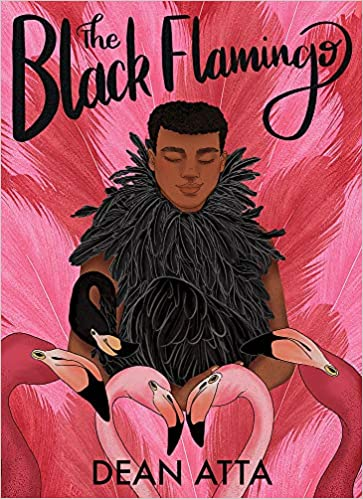
The Black Flamingo by Dean Atta
Told in accessible verse, this is the story of Michael, a mixed-race, gay teenager from London, who is on a journey to find and express himself. He discovers his voice as a drag artist when he goes to university.
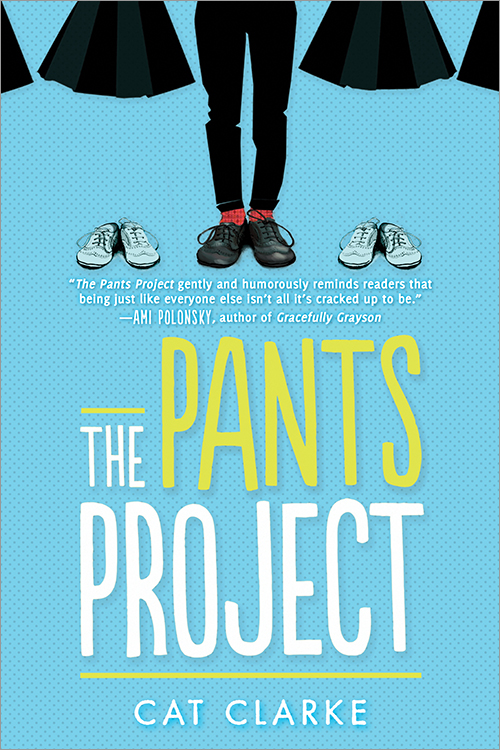
The Pants Project by Cat Clarke
When eleven-year-old Liv starts at a new school, he discovers a problem: the schools dress code prescribes pants for boys and skirts for girls. What is a girl who knows he was always meant to be a boy to do? Change the policy and, in the process, change his life!

The Witch Boy by Molly Knox Ostertag
A graphic novel about thirteen-year-old Aster whose world decrees that boys will grow up to be shapeshifters while girls are raised to be witches. Aster knows that anyone who dares to cross the lines is exiled, but he is still fascinated by witchery. He hasn’t shifted yet…is there a way to be something different than expected?
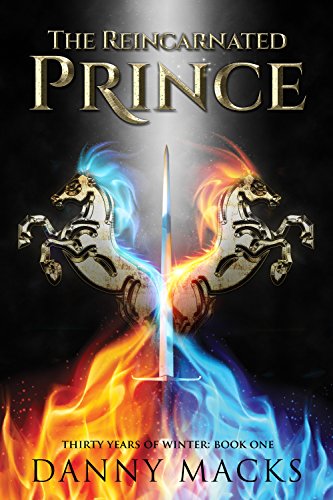
The Reincarnated Prince by Danny Macks
Set in a fantastical world where the rules about what a king should be were written hundreds of years ago, this is the story of two individuals from very different backgrounds who share little more than a birthday. As the kingdom shifts into a new season and prepares for a new king, Chad and Jeb must reconsider their lives and decide who they will become.
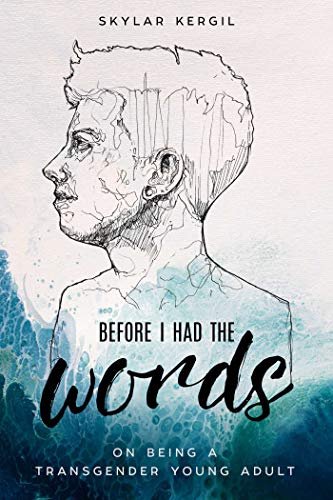
Before I Had the Words: On Being a Transgender Young Adult by Skylar Kergil
The autobiography of Skylar Kergil, who documented his physical transition from female to male on YouTube, building a community of openness and support.
Revealing entries from the author’s personal journals as well as interviews with his mother, brother, and friends lend remarkable depth to Skylar’s story.
Poem: “Ghosts and Fashion” by Elaine Equi
A playful tie-in to the idea that what we wear matters, even if we are a ghost. Poets.org provides an accompanying lesson plan with images of fashion throughout history. https://poets.org/lesson-plan/teach-poem-ghosts-and-fashion-elaine-equi
ADDITIONAL/LISTED RESOURCES
WEBSITES
- The author’s website: https://www.melaniegillman.com/
- Hungarian troupe Attraction on “Britain’s Got Talent” (https://youtu.be/Gine8SojWoY)
- TED Talk “How Fashion Helps Us Express Who We Are and What We Stand For: https://www.ted.com/talks/kaustav_dey_how_fashion_helps_us_express_who_we_are_and_what_we_stand_for
- “Color Psychology: Does It Affect How You Feel?” article: https://www.verywellmind.com/color-psychology-2795824
- Coloring mandala: http://www.supercoloring.com/coloring-pages/kaleidoscope-3
INTERVIEWS
- “Interview With Jen Wang, Author And Artist Of The Prince And The Dressmaker” interview by Book Riot: https://bookriot.com/2018/02/06/prince-and-the-dressmaker/
- “The Prince and the Dressmaker is a Genderqueer Fairy Tale For All Ages” Forbes Interview with Jen Wang: https://www.forbes.com/sites/laurenorsini/2018/02/12/the-prince-and-the-dressmaker-is-a-genderqueer-fairy-tale-for-all-ages/#6398f3b45625
ADDITIONAL RESOURCES
- Fashion-centered lesson plans on a range of themes, topics, and time periods from Bloomsbury Fashion Central: https://www.bloomsburyfashioncentral.com/lesson-plans
- American Literature’s guide to Fairy Tales: https://americanliterature.com/fairy-tales-guide
- Gender Spectrum, whose mission is “to create gender sensitive and inclusive environments for all children and teens” www.genderspectrum.org
- Queer Comics Database: http://queercomicsdatabase.com/
COMMON CORE STANDARDS
Common Core State Standards (CCSS):
Following the teaching and discussion suggestions above, The Prince and the Dressmaker can be used in classrooms to meet Common Core Standards, as detailed below. Note that this section uses the Common Core Anchor Standards for College and Career Readiness for Reading, Writing, and Speaking and Listening:
- Key ideas and details: Reading closely to determine what the texts says explicitly and making logical inferences from it; citing specific textual evidence when writing or speaking to support conclusions drawn from the text; determining central ideas or themes and analyzing their development; summarizing the key supporting details and ideas; analyzing how and why individuals, events, or ideas develop and interact over the course of the text.
- Craft and structure: Interpreting words and phrases as they are used in a text, including determining technical, connotative, and figurative meanings and analyzing how specific word choices shape meaning or tone; analyzing the structure of texts, including how specific sentences, paragraphs and larger portions of the text relate to each other and the whole; Assessing how point of view or purpose shapes the content and style of a text.
- Integration of knowledge and ideas: Integrating and evaluating content presented in diverse media and formats, including visually and quantitatively, as well as in words; delineating and evaluating the argument and specific claims in a text, including the validity of the reasoning as well as the relevance and sufficiency of the evidence; analyzing how two or more texts address similar themes or topics in order to build knowledge or to compare the approaches the author takes.
- Range of reading and level of text complexity: Reading and comprehending complex literary and informational texts independently and proficiently.
Discussion and Activity Guide: The Prince and the Dressmaker by Jen Wang
Karen Evans is Education Coordinator for CBLDF. She was a classroom teacher for 11 years, a school administrator for three years, and holds a M.Ed. in School Leadership.